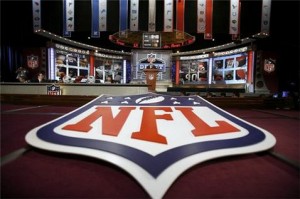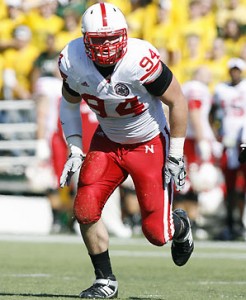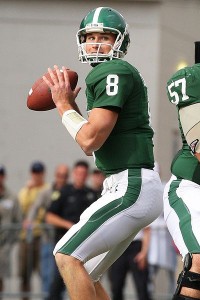When newly drafted players join their NFL teams this season, the coaches, system and competition each encounters will have a huge influence on how quickly they can make an impact. Here’s a look at the best and worst fits for players drafted in 2012. Note: this isn’t an assessment of good or bad picks, but rather an analysis of the best and worst marriages between player and team with regards to maximizing each player’s potential.
Best fits
Fletcher Cox, DT, Philadelphia (Round 1, 12th overall)
Cox should be ecstatic to be joining a defense that racked up 50 sacks last year, including 29 from Trent Cole and Jason Babin alone. Lining up next to Cullen Jenkins—who had 5.5 sacks of his own—and between Cole and Babin, Cox should see plenty of single-team blocking. Though he will have plenty of responsibility as a run defender in the Eagles’ wide nine front, Cox should be able to rack up sacks from day one in Philly.
Courney Upshaw, DE/OLB, Baltimore (Round 2, 35th overall)
The Ravens love to move dangerous front seven players like Upshaw (think Terrell Suggs or Haloti Ngata) all over the formation in a variety of fronts to wreak havoc on opponents. In Baltimore’s scheme, Upshaw should surprise opponents from everywhere, turning his “tweener label,” which likely dropped him into the second round, into a strength.
Alameda Ta’amu, DT, Pittsburgh (Round 4, 109th overall)
As a prototypical nose tackle, Ta’amu will sit and learn behind the aging Casey Hampton, who is coming off his third torn ACL and had surgery in late January. Ta’amu will be given every opportunity to become the Pro Bowler’s heir, clogging the middle for the Steelers’ tenacious defense for the next 12 years. He can’t ask for much more than that from a world-class organization.
Jared Crick, DE, Houston (Round 4, 126th overall)
Crick will fit perfectly into Phillips’ 3-4 scheme, which emphasizes penetration from big defensive ends like J.J. Watt, Antonio Smith and, of course, Crick. With a quality rotation of ends up front, flanked by dangerous linebackers in Brian Cushing, Brooks Reed and Connor Barwin, Crick should provide the Texans with plenty of production early.
Alfonzo Dennard, CB, New England (Round 7, 224th overall)
After being considered a first round possibility a month ago, Dennard was arrested for his role in a bar fight just days before the draft and, as a result, plummeted to the seventh round. Still, Dennard will join a secondary that desperately needs talent and depth, which the skilled Nebraska corner can provide. Considering the Patriots’ locker room has quieted distractions like Randy Moss and Chad Ochocinco in the past, New England might just be the best place Dennard could have landed to maximize his ability without off-field incidents.
Worst Fits
Quinton Coples, DE, New York Jets (Round 1, 16th overall)
There’s no question that Coples is talented, but the fit into Ryan’s 3-4 scheme just doesn’t quite work. As a classic 4-3 defensive end built to rush the passer, Coples is probably too big to make a smooth transition to a pass rushing linebacker. But he wouldn’t fit well at the 3-4 end either, where he’d be slightly undersized and would have to take on blocks instead of rushing the edge. He simply fits better as a 4-3 end, and as a player with questions about effort and consistency, going to a 3-4 team may stunt his development.
Cordy Glenn, T/G, Buffalo (Round 2, 41st overall)
Not that Glenn was a bad value in the early second round—he could have gone in the middle of the first—but it’s not clear where he’ll fit on the line in Buffalo. They’re already set at right tackle with Erik Pears, and Glenn isn’t athletic enough to fill the void the Bills have at left tackle. He could step into a guard position easily enough, but to get the most out of Glenn’s talent, a team with a need at right tackle might be better.
LaMichael James, RB, San Francisco (Round 2, 61st overall)
Once again, here’s a fantastic talent and a great value late in round two. But with Frank Gore and Anthony Dixon in place already and Brandon Jacobs joining the team in free agency, James will be part of an awfully crowded backfield that may limit him to pass-catching situations. James may still have a great rookie year and ultimately become a star, but ideally he wouldn’t be sharing reps with quite so many other backs.
Bryan Anger, P, Jacksonville (Round 3, 70th overall)
Any punter picked 70th overall can’t be a good fit. Enough said.
Kirk Cousins, QB, Washington (Round 4, 102nd overall)
Though it’s no QB controversy with Robert Griffin III and Cousins, there’s no doubt the latter isn’t in a great situation. He knows he won’t have the chance to start for at least two years and that chance will almost certainly be with another team. While Mike Shanahan could help Cousins develop, RG III will take most of Shanahan’s time and focus. Ultimately, Cousins would be much better off with a team like Jacksonville, Kansas City or Buffalo where in a year or two, he could prove himself worthy of starting.


